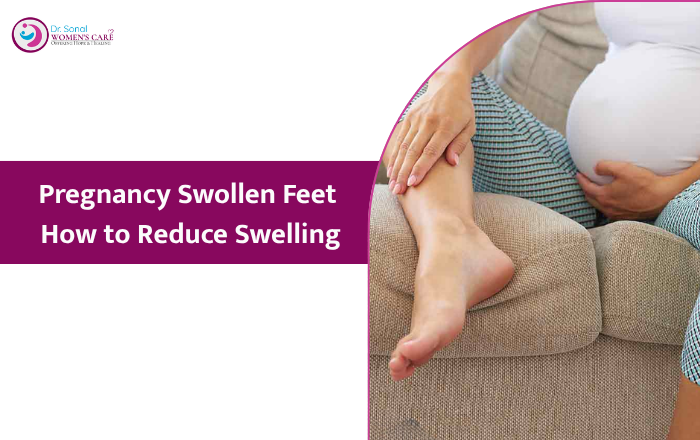Pregnancy brings many changes—some joyful, some uncomfortable. One common issue many expecting mothers face is swelling in the feet and ankles. You’re not alone if your shoes suddenly feel tighter or your ankles disappear by the end of the day. This kind of swelling, known as edema, is usually normal during pregnancy, especially in the later months.
In this post, you’ll learn why swelling happens, safe and natural ways to reduce it, and when it’s a good idea to speak to a doctor. If you’re in Ambegaon Budruk, we’ll also introduce you to someone who can help you through your pregnancy journey.
Why Does Swelling Happen During Pregnancy?
Swelling in pregnancy is usually caused by your body holding more water than usual. As your baby grows, the uterus puts pressure on the veins in your legs, which can slow down blood flow and cause fluid to collect in your feet and ankles.
Some common reasons for swelling include:
- Increased fluid retention
- Hormonal changes
- Hot weather
- Standing or sitting for long periods
Swelling tends to be more noticeable in the third trimester and often gets worse at the end of the day.
10 Natural Ways to Reduce Swelling in Feet and Ankles During Pregnancy
If swelling is making you uncomfortable, try these safe and easy tips to feel better:
1. Put Your Feet Up
Whenever you get the chance, elevate your feet above heart level using a pillow. This helps the fluid flow back toward your heart and reduces pooling in your ankles.
2. Drink Plenty of Water
It might seem strange, but drinking more water helps your body flush out excess fluids and reduce swelling.
3. Use Compression Socks
Wearing gentle compression socks can support blood flow and stop fluid from gathering around your feet and ankles. Put them on in the morning before swelling begins.
4. Keep Moving
Light activities like walking, swimming, or prenatal yoga help improve circulation. Just a short walk every few hours can make a big difference.
5. Eat Less Salt
Salt makes your body hold onto water. Try cutting back on salty snacks and processed foods.
6. Eat Potassium-Rich Foods
Foods like bananas, avocados, and sweet potatoes are full of potassium, which helps balance fluids in your body.
7. Try Gentle Foot Massage
A soft massage with upward strokes toward your knees can help move trapped fluid and give you some relief.
8. Avoid Standing or Sitting Too Long
If you sit at a desk, take breaks to stretch or walk around. If you stand a lot, try to sit down with your feet up when you can.
9. Apply a Cold Compress
A cool cloth or ice pack can ease discomfort. Wrap it in a towel and place it on your feet or ankles for 15–20 minutes.
10. Sleep on Your Left Side
Sleeping on your left side improves blood flow to your heart and kidneys, helping your body get rid of excess fluid more efficiently.
What to Eat (and Avoid) to Reduce Pregnancy Swelling
Your diet plays a big role in how much swelling you experience. Here’s what can help:
✔️ Eat More:
- Watermelon, cucumbers, and other water-rich fruits
- Leafy greens and berries
- Bananas and oranges (for potassium)
- Brown rice and whole grains
❌ Avoid:
- Salty snacks like chips and processed meats
- Fast food
- Canned soups and sauces high in sodium
Lifestyle Changes That Help
In addition to diet and rest, small changes to your daily routine can also reduce swelling:
- Wear comfortable shoes with good arch support
- Avoid tight clothing, especially around your legs
- Stay cool during hot weather by using a fan or staying indoors
- Elevate your legs when resting or watching TV
- Try gentle stretches after sitting for long periods
When to Worry: Signs You Shouldn’t Ignore
While swelling is usually nothing to worry about, there are times when it can signal something more serious.
Call your doctor if you notice:
- Sudden or extreme swelling, especially in the face or hands
- Swelling that only affects one leg
- Headaches, blurred vision, or chest pain
- Pain when touching your calf or moving your leg
These could be signs of preeclampsia or deep vein thrombosis (DVT), and it’s important to get checked right away.
If you’re pregnant and dealing with swelling or any other concerns, it’s important to talk to someone you trust.
We suggest visiting Dr. Sonal Katarmal, a pregnancy care specialist in Ambegaon Budruk, at Dr. Sonal Women’s Care. She can guide you with simple tips and check whether your swelling is normal or needs attention.
FAQs About Swelling During Pregnancy
1. Is swelling in feet and ankles normal during pregnancy?
Yes, especially in the second and third trimesters. It’s usually caused by fluid retention and pressure on your veins.
2. When does swelling usually start in pregnancy?
Some women notice swelling as early as the second trimester, but it often becomes more noticeable in the last 3 months.
3. Should I worry if only one foot is swollen?
Swelling in one foot or leg, especially if it’s painful, can be a sign of a blood clot. Contact your doctor right away.
Swollen feet and ankles during pregnancy can be frustrating, but there are many safe and natural ways to find relief. From simple stretches to eating the right foods, small changes can help you feel more comfortable as your body prepares for your baby’s arrival.
If you’re in Ambegaon Budruk and want to know more about what’s normal during pregnancy or how to ease your symptoms, don’t hesitate to reach out to Dr. Sonal Katarmal at Dr. Sonal Women’s Care.
You deserve to feel supported and informed every step of the way.

